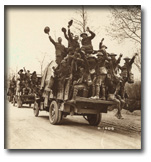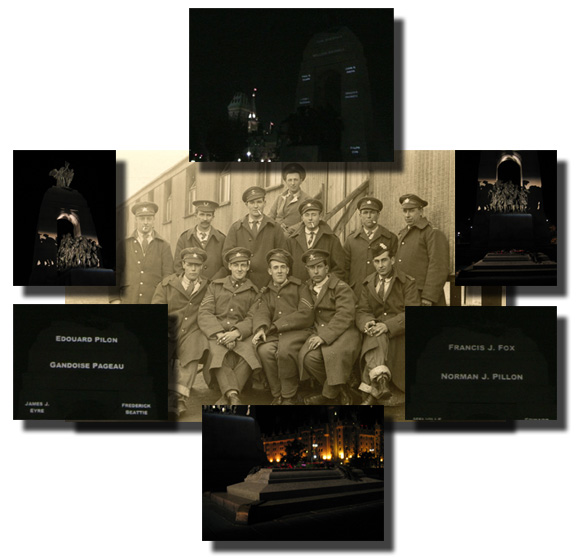 |
 |
 |
 |
In November of 2008, a truly wonderful project was carried out. Its goal was to remember the Canadians who had fallen on the battlefields of Europe during those five dreadful years of hell in the early XXth century. Each year on the 11th of November, the whole country gathers to remember, but fewer and fewer actually experienced what it was we were supposed to remember. Vigil 1914-1918 was an effort to recognize the individuals, not only the collectivity, before the last of those soldiers who had known that war had disappeared forever. And so, during one full week, ending on November the 11th, every night from sunset to sunrise the next morning, the names of 68,000 fallen were projected onto the national war memorial in the heart of Ottawa as well as on Canada House in London, England. It was like a parade of our heros. For a few brief seconds, the names of each and every Canadian who had died in the First World War were briefly projected, two at a time in large letters atop the cenotaph, then moved down onto the monument's legs for another few seconds to finally disappear. A well planned website allowed us to find out the exact date and time when a name would be projected (you can still visit the site). There was no apparent order to their appearance: they were not alphabetical, nor were they arranged in the order they had fallen, nor by the date of the death. The names of two Canadian Pilons were among these. The first was Norman J. Pillon (the use of two letters "L" in his name is a transcription error because he signed his name with only one). He died of wounds on November 6, 1918. The second Pilon to appear was Edouard who died on July 5, 1916. Norman's name illuminated the cenotaph at 8:33 p.m. on November 5 and Edouard's the next evening, November 6 at 9:54 p.m. The weather that whole week was exceptional for that time of the year. I made certain to be at the cenotaph well before the times because I wanted to capture the moment and feel a bit of the atmosphere surrounding the whole event. The city seemed oblivious to what was taking place. There were a few people at any one time standing and watching, but really, not that many. The projector was discreetly located on the plaza. As the time approached for the first Pilon, I prepared my video camera well ahead of time because I wanted to capture the very moment and it would be brief. At several times I thought I had missed it, but at exactly 8:33 p.m. Norman J. Pillon appeared at the top of the monument, just under the angels. On the video I can be heard spontaneously saying "There he is". Not "There is his name". The magic that the creators of this project (RH Thomson and Martin Conboy) had conceived worked like a charm. It was as if this relative I had never met was actually there in front of me. I will never forget that moment. But this magic did not end there. The next day I realized that at the very moment that Norman Pillon's name appeared in Ottawa, in France where he had died, it was in the early hours of November 6, thus his name appeared in Ottawa 90 years, day for day, after the day he passed from this world to the next. How could this possibly have happened given how random the names seemed to be appearing. I have no answer. The next evening, accompanied by my son Thomas, I once again found myself at the foot of the tomb of the Unknown, waiting this time for the name of Edouard Pilon to appear. Edouard had been declared missing and presumed killed during an early morning trench raid near Ypres in Belgium in the summer of 1916. Like the Unknown at the cenotaph, Edouard's grave is not known. Instead, his name, along with countless thousands of other Canadians, is inscribed on the stone walls of the Menin Gate in Ypres. It was good to have my son with me this night because we had been together in Ypres in 2006 and visited the cold walls of the gate there, paying tribute to this distant relative whose example remains for us a source of inspiration. We eventually made our way to a local pub, D'Arcy McGhee's from where we could still see the monument and the slowly changing names. We raised a glass in their honour and to the honour of all those who were finally having their victory parade in their country's capital, 90 years after the end of the war to end all wars.  |